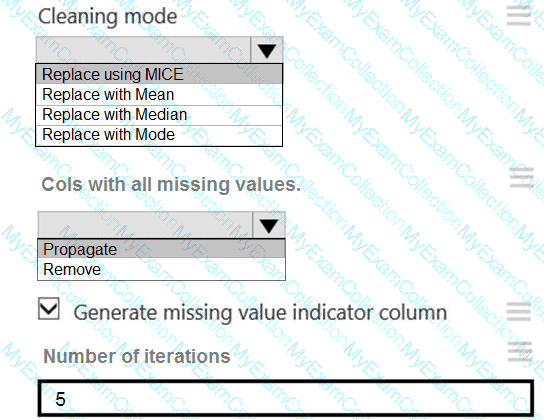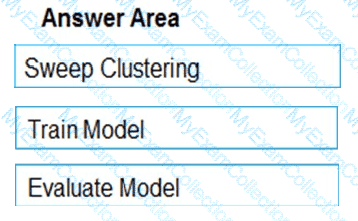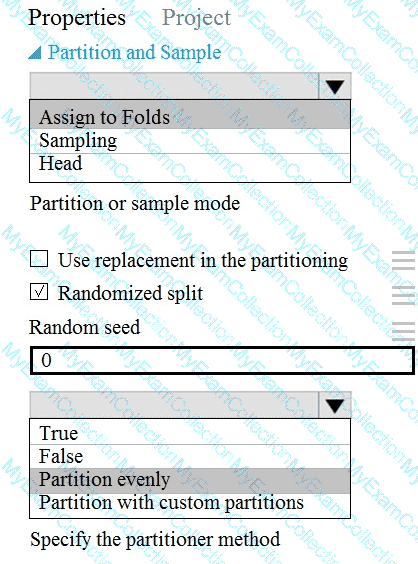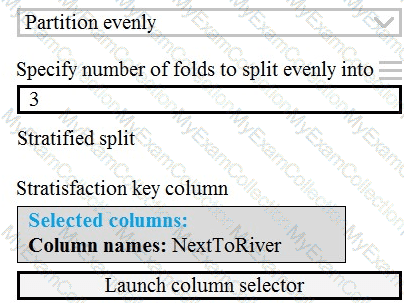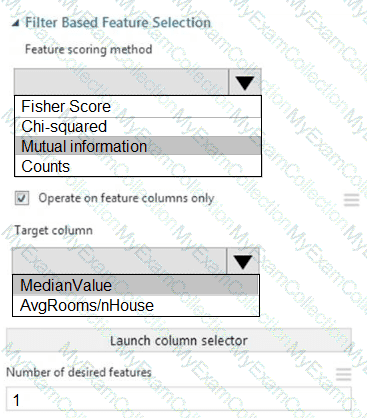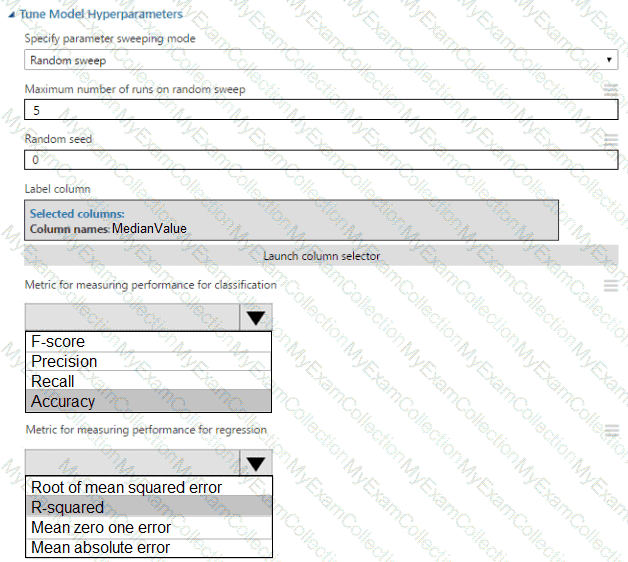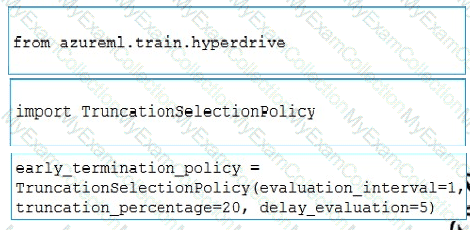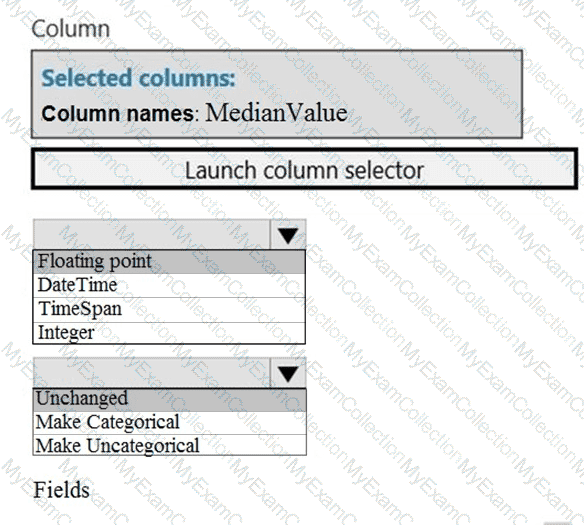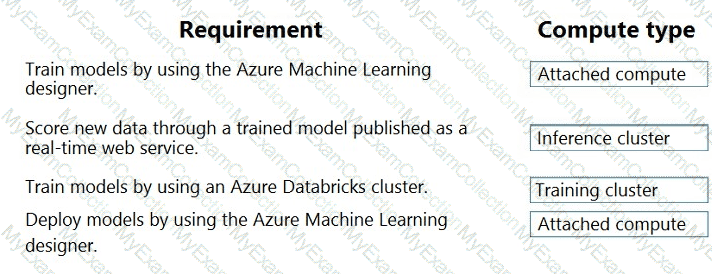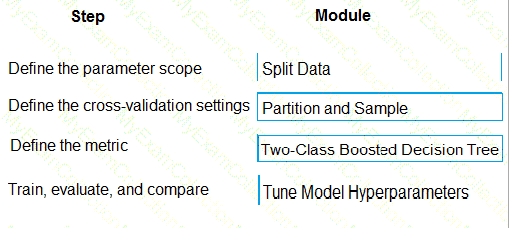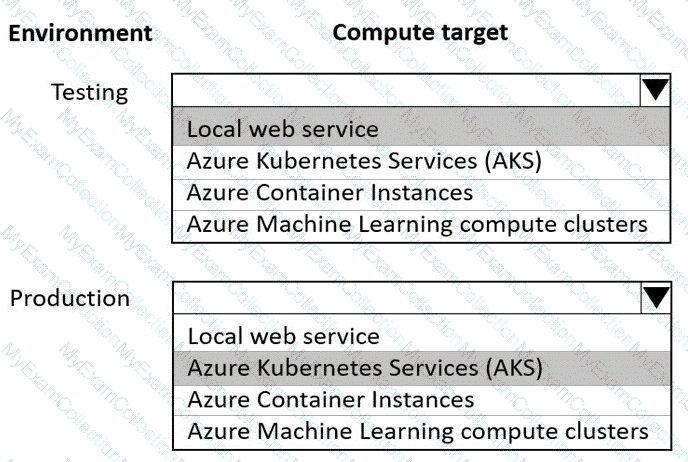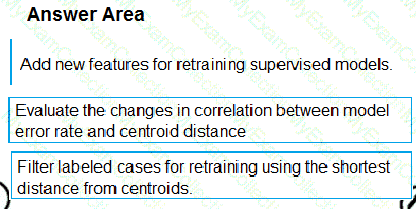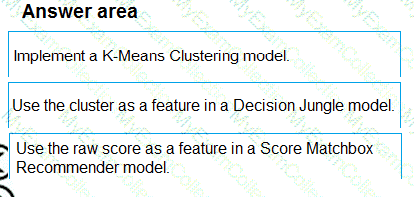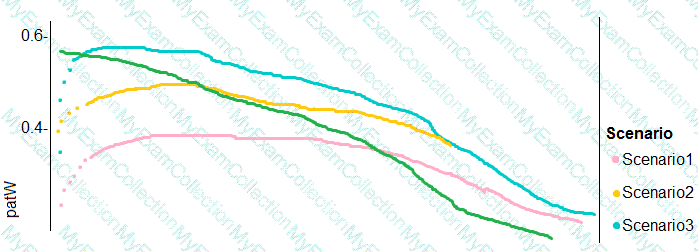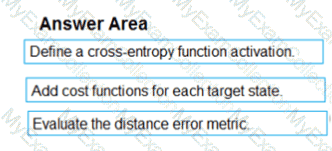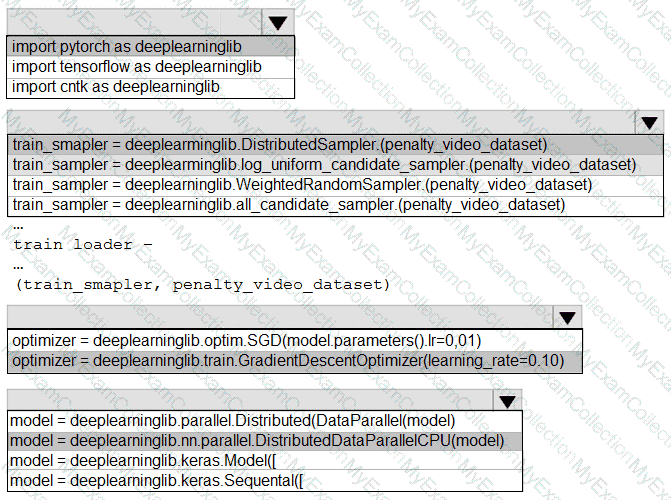You need to visually identify whether outliers exist in the Age column and quantify the outliers before the outliers are removed.
Which three Azure Machine Learning Studio modules should you use in sequence? To answer, move the appropriate modules from the list of modules to the answer area and arrange them in the correct order.
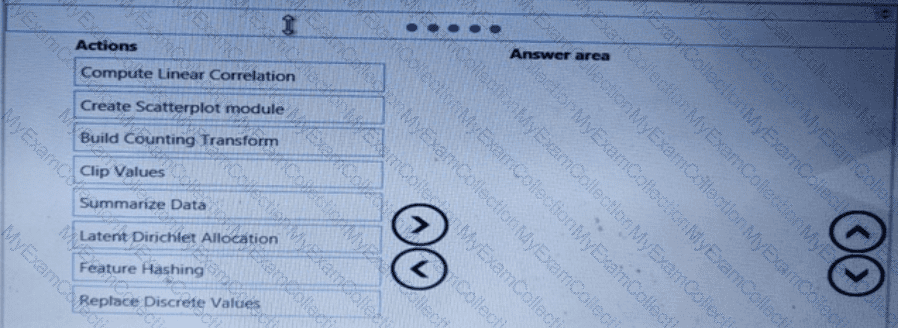
You need to select a feature extraction method.
Which method should you use?
You need to replace the missing data in the AccessibilityToHighway columns.
How should you configure the Clean Missing Data module? To answer, select the appropriate options in the answer area.
NOTE: Each correct selection is worth one point.
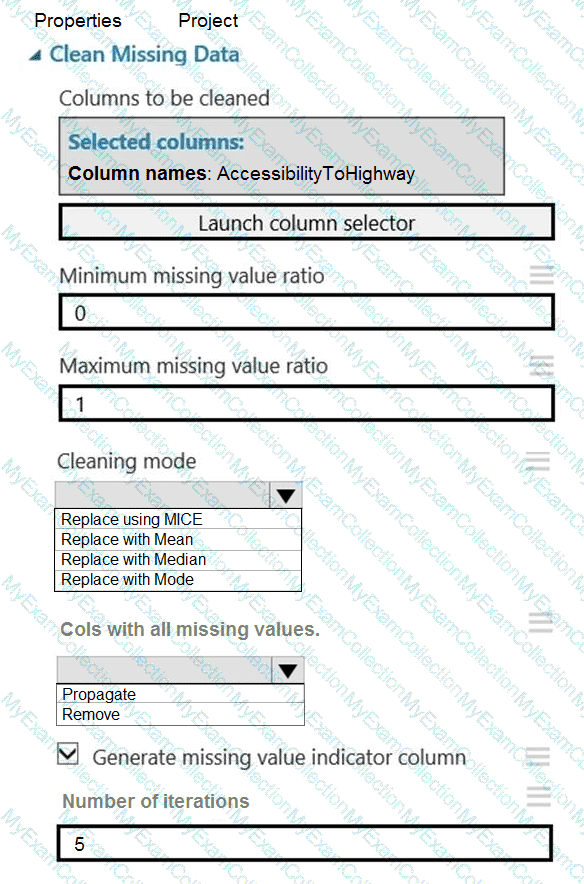
You need to produce a visualization for the diagnostic test evaluation according to the data visualization requirements.
Which three modules should you recommend be used in sequence? To answer, move the appropriate modules from the list of modules to the answer area and arrange them in the correct order.
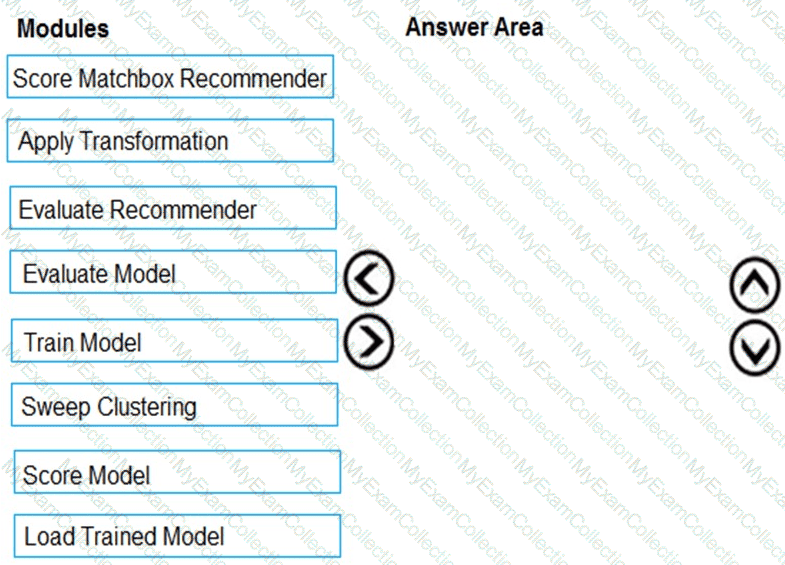
You need to identify the methods for dividing the data according to the testing requirements.
Which properties should you select? To answer, select the appropriate options in the answer area.
NOTE: Each correct selection is worth one point.
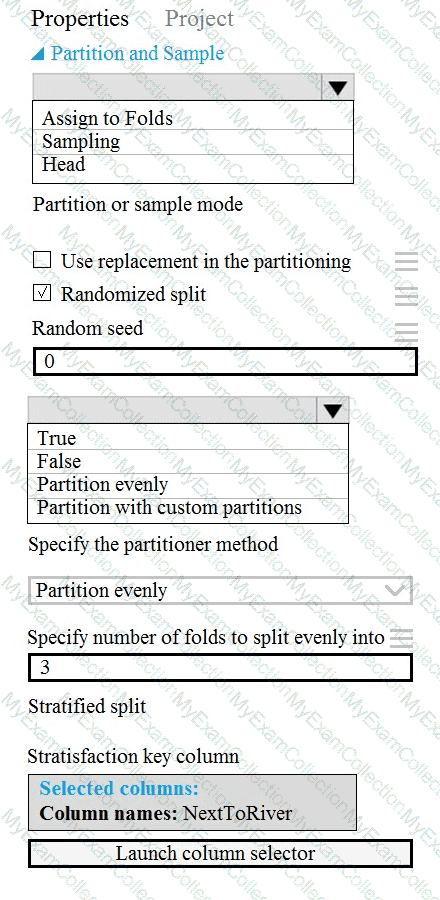
You need to configure the Feature Based Feature Selection module based on the experiment requirements and datasets.
How should you configure the module properties? To answer, select the appropriate options in the dialog box in the answer area.
NOTE: Each correct selection is worth one point.
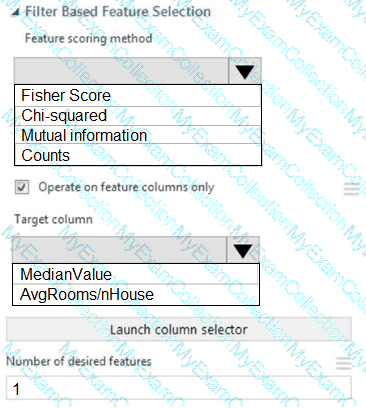
You need to set up the Permutation Feature Importance module according to the model training requirements.
Which properties should you select? To answer, select the appropriate options in the answer area.
NOTE: Each correct selection is worth one point.
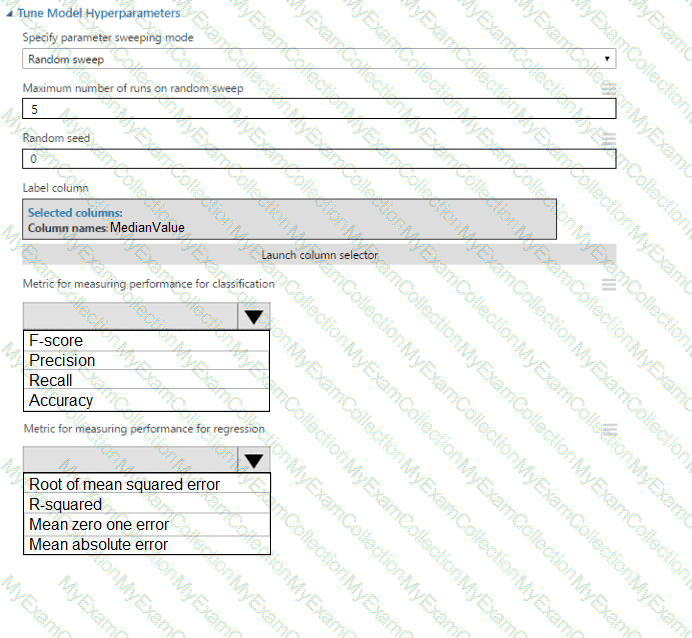
You need to identify the methods for dividing the data according, to the testing requirements.
Which properties should you select? To answer, select the appropriate option-, m the answer area. NOTE: Each correct selection is worth one point.
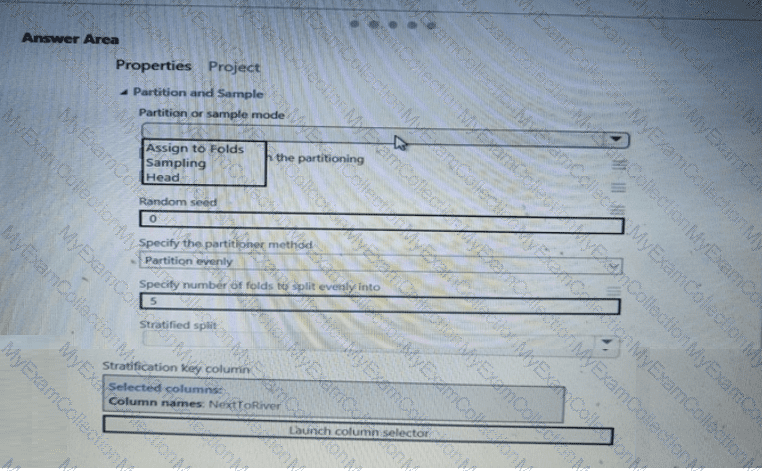
You need to implement early stopping criteria as suited in the model training requirements.
Which three code segments should you use to develop the solution? To answer, move the appropriate code segments from the list of code segments to the answer area and arrange them in the correct order.
NOTE: More than one order of answer choices is correct. You will receive credit for any of the correct orders you select.
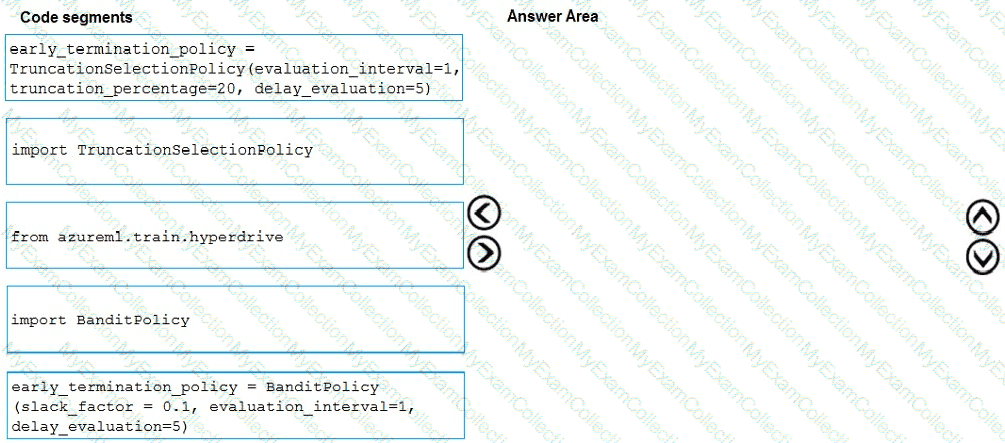
You need to configure the Edit Metadata module so that the structure of the datasets match.
Which configuration options should you select? To answer, select the appropriate options in the answer area.
NOTE: Each correct selection is worth one point.
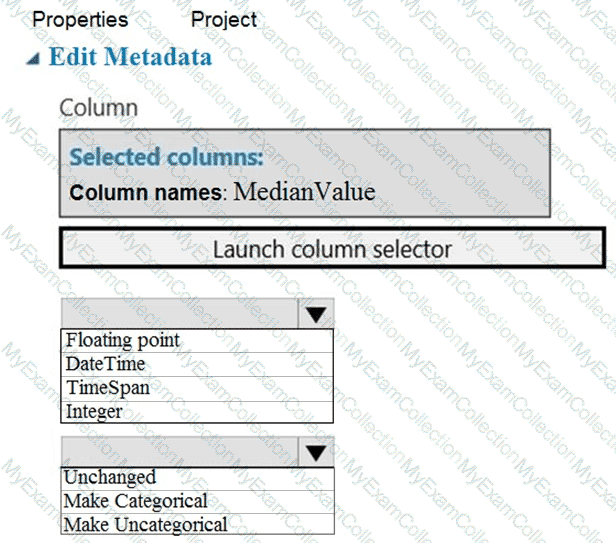
You create an Azure Machine learning workspace.
You are use the Azure Machine -learning Python SDK v2 to define the search space for concrete hyperparafneters. The hyper parameters must consist of a list of predetermined, comma-separated.
You need to import the class from the azure ai ml. sweep package used to create the list of values.
Which class should you import?
You create a binary classification model. You use the Fairlearn package to assess model fairness. You must eliminate the need to retrain the model. You need to implement the Fair learn package. Which algorithm should you use?
You create a workspace to include a compute instance by using Azure Machine Learning Studio. You are developing a Python SDK v2 notebook in the workspace. You need to use Intellisense in the notebook. What should you do?
You are building a binary classification model by using a supplied training set.
The training set is imbalanced between two classes.
You need to resolve the data imbalance.
What are three possible ways to achieve this goal? Each correct answer presents a complete solution NOTE: Each correct selection is worth one point.
You run a script as an experiment in Azure Machine Learning.
You have a Run object named run that references the experiment run. You must review the log files that were generated during the experiment run.
You need to download the log files to a local folder for review.
Which two code segments can you run to achieve this goal? Each correct answer presents a complete solution.
NOTE: Each correct selection is worth one point.
You are creating a machine learning model that can predict the species of a penguin from its measurements. You have a file that contains measurements for free species of penguin in comma delimited format.
The model must be optimized for area under the received operating characteristic curve performance metric averaged for each class.
You need to use the Automated Machine Learning user interface in Azure Machine Learning studio to run an experiment and find the best performing model.
Which five actions should you perform in sequence? To answer, move the appropriate actions from the list of actions to the answer area and arrange them in the collect order.

You use Azure Machine Learning Designer to load the following datasets into an experiment:
Data set 1

Dataset 2

You need to create a dataset that has the same columns and header row as the input datasets and contains all rows from both input datasets.
Solution: Use the Apply Transformation component.
Does the solution meet the goal?
You load data from a notebook in an Azure Machine Learning workspace into a panda’s cat frame. The data contains 10.000 records. Each record consists of 10 columns.
You must identify the number of missing values in each of the columns.
You need to complete the Python code that will return the number of missing values in each of the columns.
Which code segments should you use? To answer, select the appropriate options «i the answer area.
NOTE; Each correct selection it worth one point.

You have an Azure Machine Learning workspace.
You plan to use Azure Machine Learning Python SDK v2 to register a component in the workspace The component definition is stored in the local file ./components/train/train.yml.
You write code to connect to the workspace by using the ml_client object and import all required libraries
You need to complete the remaining code.
How should you complete the code? to answer, select the appropriate options in the answer area.
NOTE: Each correct selection is worth one point.
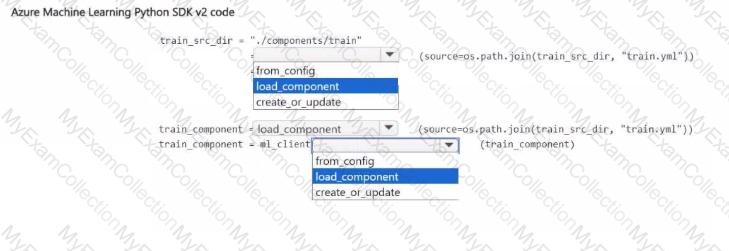
You are performing a filter based feature selection for a dataset 10 build a multi class classifies by using Azure Machine Learning Studio.
The dataset contains categorical features that are highly correlated to the output label column.
You need to select the appropriate feature scoring statistical method to identify the key predictors. Which method should you use?
You use the Azure Machine Learning designer to create and run a training pipeline. You then create a real-time inference pipeline.
You must deploy the real-time inference pipeline as a web service.
What must you do before you deploy the real-time inference pipeline?
You manage an Azure Machine Learning workspace.
You configure a standalone Apache Spark job in the workspace by using Python SDK v2.
You need to create the job by using an Azure Machine Learning serverless Spark compute with input output, and user identity. Which two classes should you configure? Each correct answer presents part of the solution. Choose two. NOTE: Each correct selection is worth one point.
You manage an Azure Machine Learning workspace. The Pylhon scrip! named scriptpy reads an argument named training_data. The trainlng.data argument specifies the path to the training data in a file named datasetl.csv.
You plan to run the scriptpy Python script as a command job that trains a machine learning model.
You need to provide the command to pass the path for the datasct as a parameter value when you submit the script as a training job.
Solution: python script.py –training_data ${{inputs,training_data}}
Does the solution meet the goal?
You create an Azure Machine Learning pipeline named pipeline 1 with two steps that contain Python scnpts. Data processed by the first step is passed to the second step.
You must update the content of the downstream data source of pipeline 1 and run the pipeline again.
You need to ensure the new run of pipeline 1 fully processes the updated content.
Solution: Change the value of the compute.target parameter of the PythonScriptStep object in the two steps.
Does the solution meet the goal'
You create an Azure Machine Learning dataset containing automobile price data The dataset includes 10,000 rows and 10 columns You use Azure Machine Learning Designer to transform the dataset by using an Execute Python Script component and custom code.
The code must combine three columns to create a new column.
You need to configure the code function.
Which configurations should you use? lo answer, select the appropriate options in the answer area
NOTE: Each correct selection is worth one point.
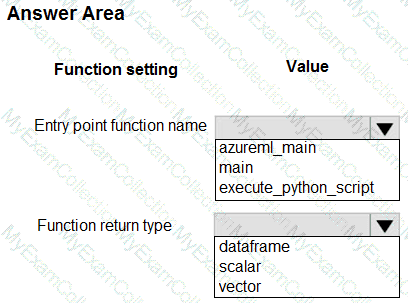
You create machine learning models by using Azure Machine Learning.
You plan to train and score models by using a variety of compute contexts. You also plan to create a new compute resource in Azure Machine Learning studio.
You need to select the appropriate compute types.
Which compute types should you select? To answer, drag the appropriate compute types to the correct requirements. Each compute type may be used once, more than once, or not at all. You may need to drag the split bar between panes or scroll to view content.
NOTE: Each correct selection is worth one point.

You manage an Azure Machine Learning workspace. The development environment for managing the workspace is configured to use Python SDK v2 in Azure Machine Learning Notebooks.
A Synapse Spark Compute is currently attached and uses system-assigned identity.
You need to use Python code to update the Synapse Spark Compute to use a user-assigned identity.
Solution: Initialize the DefaultAzureCredential class.
Does the solution meet the goal?
You are building a machine learning model for translating English language textual content into French
language textual content.
You need to build and train the machine learning model to learn the sequence of the textual content.
Which type of neural network should you use?
You have a model with a large difference between the training and validation error values.
You must create a new model and perform cross-validation.
You need to identify a parameter set for the new model using Azure Machine Learning Studio.
Which module you should use for each step? To answer, drag the appropriate modules to the correct steps. Each module may be used once or more than once, or not at all. You may need to drag the split bar between panes or scroll to view content.
NOTE: Each correct selection is worth one point.

You are managing an Azure Machine Learning workspace.
You must tune a hyperparameter for a neural network model. The learning rate must be a continuous hyperparameter between 0.001 and 0.1. The batch size can be 32.64. or 128.
You need to select the appropriate search space for each parameter.
Which search space should you use? To answer, move the appropriate search spaces to the correct hyperparameters. You may use each search space option once, more than once, or not at all. You may need to move the split bar between panes or scroll to view content.
NOTE: Each correct selection is worth one point.

You are creating a machine learning model. You have a dataset that contains null rows.
You need to use the Clean Missing Data module in Azure Machine Learning Studio to identify and resolve the null and missing data in the dataset.
Which parameter should you use?
You create an Azure Machine Learning workspace. You use the Azure Machine Learning Python SDK v2 to create a compute cluster.
The compute cluster must run a training script. Costs associated with running the training script must be minimized.
You need to complete the Python script to create the compute cluster.
How should you complete the script? To answer, select the appropriate options in the answer area.
NOTE: Each correct selection is worth one point.
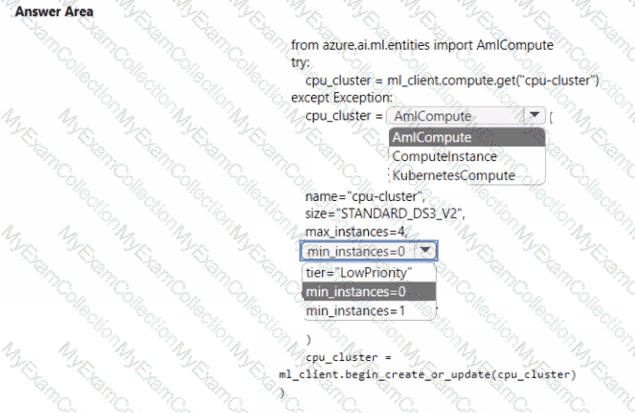
You create an Azure Machine Learning workspace. You use Azure Machine Learning designer to create a pipeline within the workspace. You need to submit a pipeline run from the designer.
What should you do first?
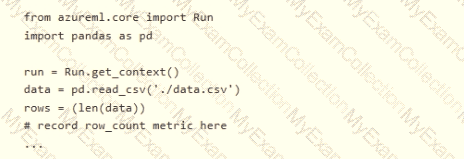
You need to record the row count as a metric named row_count that can be returned using the get_metrics method of the Run object after the experiment run completes. Which code should you use?
You are developing a hands-on workshop to introduce Docker for Windows to attendees.
You need to ensure that workshop attendees can install Docker on their devices.
Which two prerequisite components should attendees install on the devices? Each correct answer presents part of the solution.
NOTE: Each correct selection is worth one point.
You train and register a machine learning model. You create a batch inference pipeline that uses the model to generate predictions from multiple data files.
You must publish the batch inference pipeline as a service that can be scheduled to run every night.
You need to select an appropriate compute target for the inference service.
Which compute target should you use?
You manage an Azure Machine Learning workspace. You build a model for which you must configure a Responsible Al dashboard. Based on what you learn from the dashboard, you must perform the following activities:
• Determine what must be done to get a desirable outcome from the model.
• Identify the features that have the most direct effect on your outcome of interest.
You need to select the components to use for the Responsible Al dashboard configuration. Which two components should you add? Each correct answer presents part of the solution. NOTE: Each correct selection is worth one point.
: 215
Note: This question is part of a series of questions that present the same scenario. Each question in the series contains a unique solution that might meet the stated goals. Some question sets might have more than one correct solution, while others might not have a correct solution.
After you answer a question in this section, you will NOT be able to return to it. As a result, these questions will not appear in the review screen.
You train a classification model by using a logistic regression algorithm.
You must be able to explain the model’s predictions by calculating the importance of each feature, both as an overall global relative importance value and as a measure of local importance for a specific set of predictions.
You need to create an explainer that you can use to retrieve the required global and local feature importance values.
Solution: Create a MimicExplainer.
Does the solution meet the goal?
You plan to use automated machine learning by using Azure Machine Learning Python SDK v2 to train a regression model. You have data that has features with missing values, and categorical features with few distinct values.
You need to control whether automated machine learning automatically imputes missing values and encode categorical features as part of the training task. Which enemy of the autumn package should you use?
You plan to run a Python script as an Azure Machine Learning experiment.
The script must read files from a hierarchy of folders. The files will be passed to the script as a dataset argument.
You must specify an appropriate mode for the dataset argument.
Which two modes can you use? Each correct answer presents a complete solution.
NOTE: Each correct selection is worth one point.
You are using an Azure Machine Learning workspace. You set up an environment for model testing and an environment for production.
The compute target for testing must minimize cost and deployment efforts. The compute target for production must provide fast response time, autoscaling of the deployed service, and support real-time inferencing.
You need to configure compute targets for model testing and production.
Which compute targets should you use? To answer, select the appropriate options in the answer area.
NOTE: Each correct selection is worth one point.
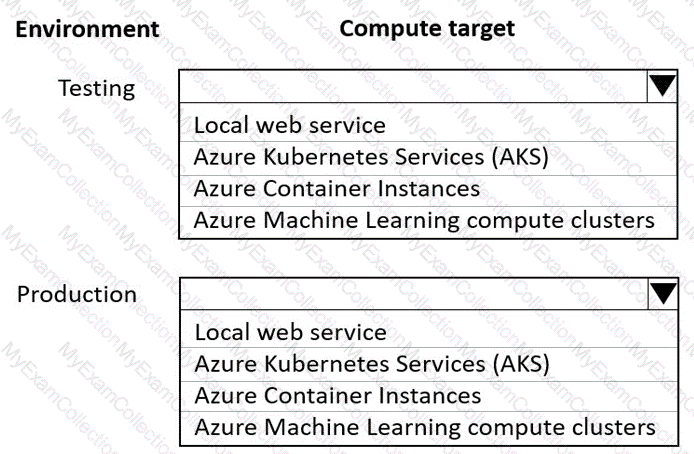
You train a classification model by using a decision tree algorithm.
You create an estimator by running the following Python code. The variable feature_names is a list of all feature names, and class_names is a list of all class names.
from interpret.ext.blackbox import TabularExplainer

You need to explain the predictions made by the model for all classes by determining the importance of all features.
For each of the following statements, select Yes if the statement is true. Otherwise, select No.
NOTE: Each correct selection is worth one point.

You ate reviewing model benchmarks in Azure Al Foundry.
You must use a large language model based on the proficiency of the model to generate the most linguistically correct text. You need to select the model benchmark. Which benchmark metric should you focus on?
You manage an Azure Al Foundry project.
You plan to evaluate a fine-tuned large language model by doing the following:
• Identifying discrepancies between runs of the same model to pinpoint the areas where adjustments may be needed.
• Verifying the Al-generated responses align with and are validated by the provided context.
You need to identify an evaluation metric and a comparison feature to assess the performance of the model. Which assessment techniques should you use? To answer, select the appropriate options in the answer area.
NOTE: Each correct selection is worth one point.
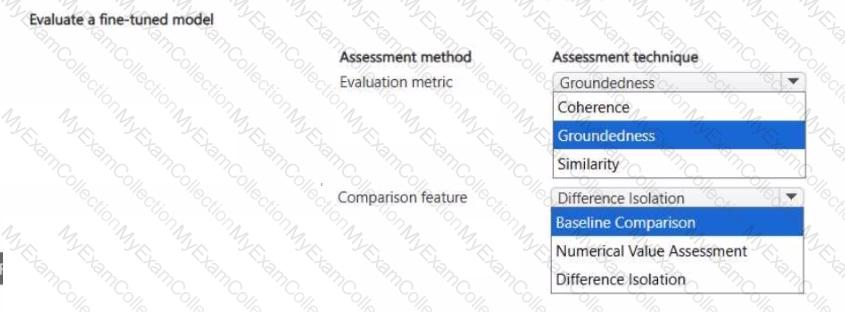
You use Azure Machine Learning studio to analyze an mltable data asset containing a decimal column named column1. You need to verify that the column1 values are normally distributed.
Which statistic should you use?
You have the following Azure subscriptions and Azure Machine Learning service workspaces:

You need to obtain a reference to the ml-project workspace.
Solution: Run the following Python code:

Does the solution meet the goal?
You need to define a process for penalty event detection.
Which three actions should you perform in sequence? To answer, move the appropriate actions from the list of actions to the answer area and arrange them in the correct order.
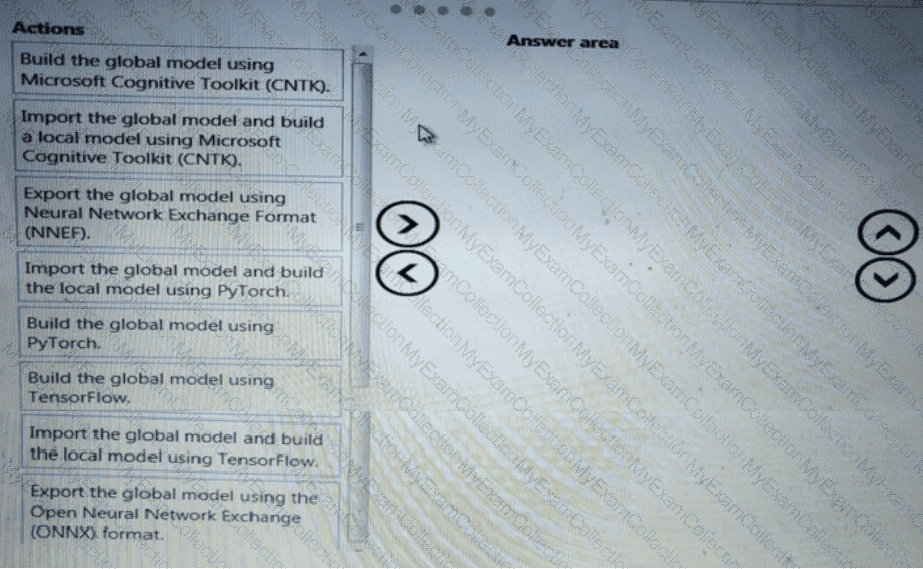
You manage an Azure Machine Learning workspace named workspaces
You plan to create a registry named registry01 with the help of the following registry.yml (line numbers are used for reference only):

You need to use Azure Machine Learning Python SDK v2 with Python 3.10 in a notebook to interact with workspace1.
Which three actions should you perform in sequence? To answer, move the appropriate actions from the list of actions to the answer area and arrange them in the correct order.

You need to define an evaluation strategy for the crowd sentiment models.
Which three actions should you perform in sequence? To answer, move the appropriate actions from the list of actions to the answer area and arrange them in the correct order.
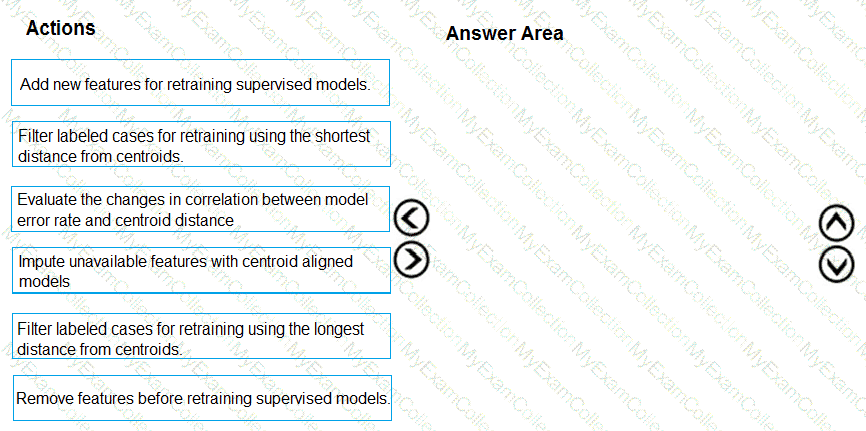
You need to build a feature extraction strategy for the local models.
How should you complete the code segment? To answer, select the appropriate options in the answer area.
NOTE: Each correct selection is worth one point.
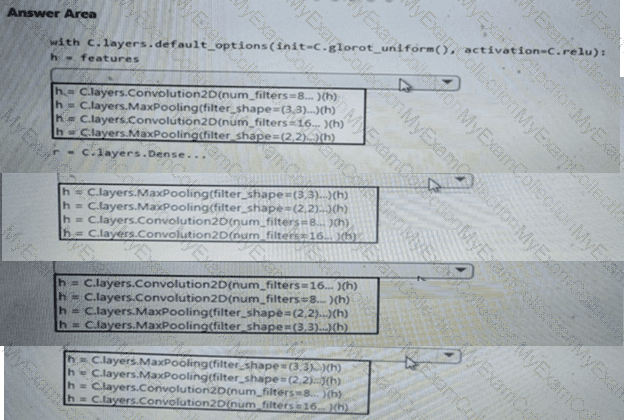
You need to resolve the local machine learning pipeline performance issue. What should you do?
You need to define a modeling strategy for ad response.
Which three actions should you perform in sequence? To answer, move the appropriate actions from the list of actions to the answer area and arrange them in the correct order.
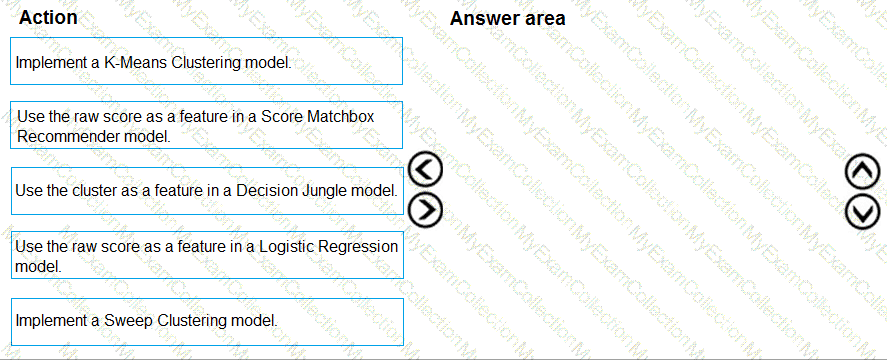
You need to implement a new cost factor scenario for the ad response models as illustrated in the
performance curve exhibit.
Which technique should you use?
You need to define an evaluation strategy for the crowd sentiment models.
Which three actions should you perform in sequence? To answer, move the appropriate actions from the list of actions to the answer area and arrange them in the correct order.
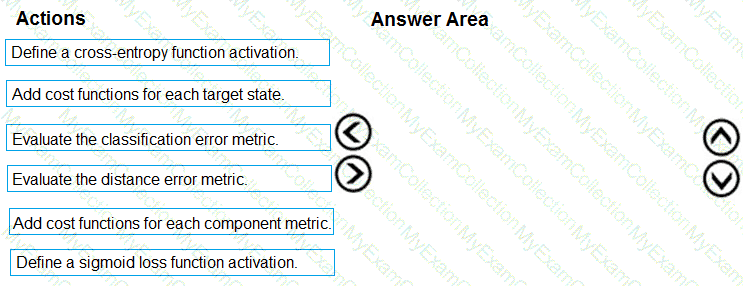
You need to modify the inputs for the global penalty event model to address the bias and variance issue.
Which three actions should you perform in sequence? To answer, move the appropriate actions from the list of actions to the answer area and arrange them in the correct order.
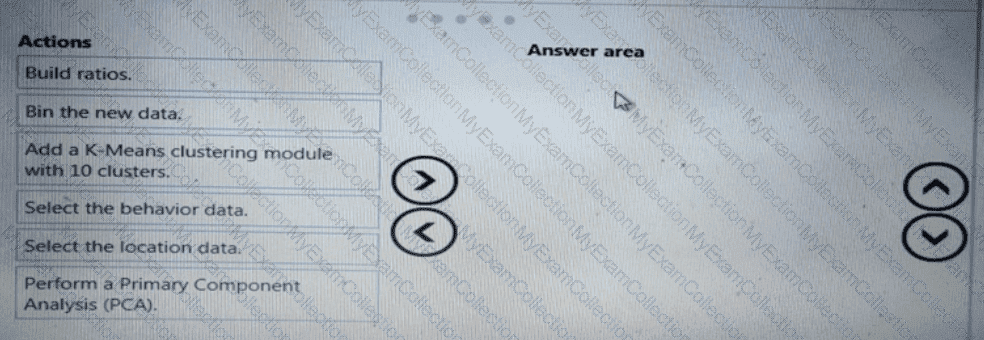
You need to use the Python language to build a sampling strategy for the global penalty detection models.
How should you complete the code segment? To answer, select the appropriate options in the answer area.
NOTE: Each correct selection is worth one point.
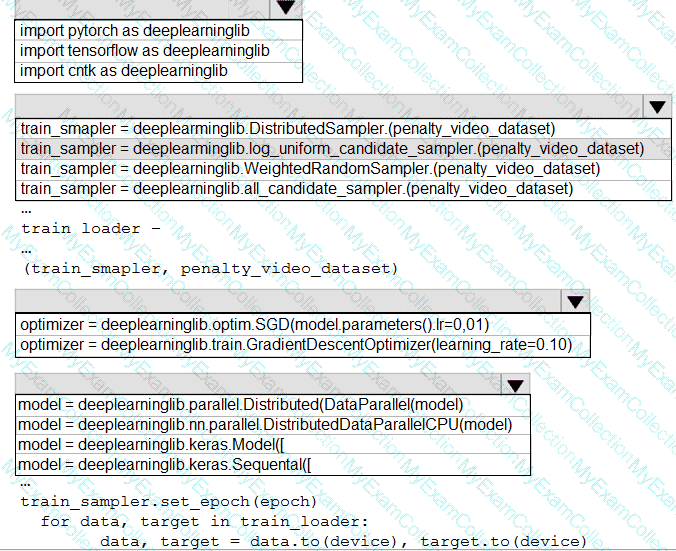
You need to implement a feature engineering strategy for the crowd sentiment local models.
What should you do?
You need to define a process for penalty event detection.
Which three actions should you perform in sequence? To answer, move the appropriate actions from the list of actions to the answer area and arrange them in the correct order.
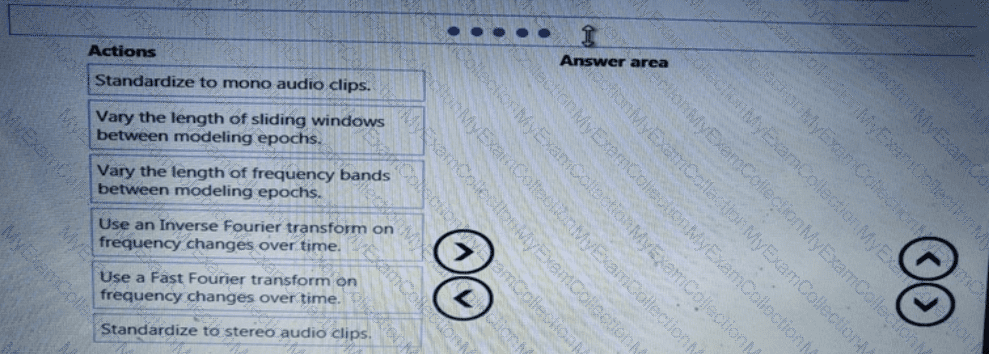
You need to implement a scaling strategy for the local penalty detection data.
Which normalization type should you use?
You need to implement a model development strategy to determine a user’s tendency to respond to an ad.
Which technique should you use?
You need to select an environment that will meet the business and data requirements.
Which environment should you use?


